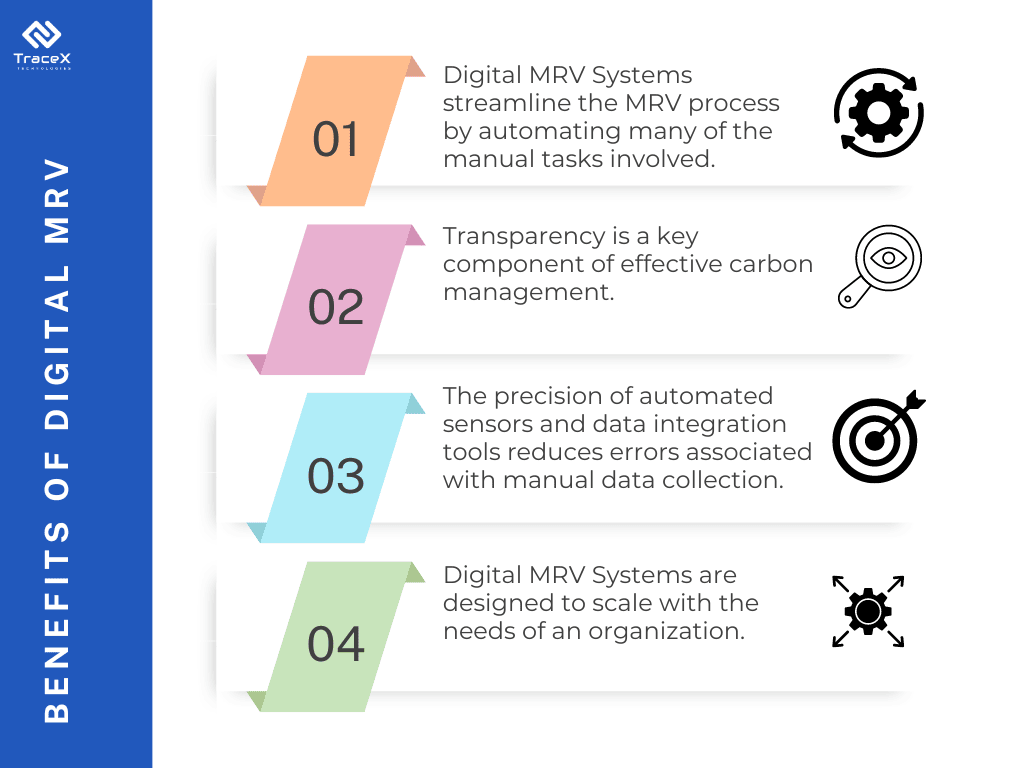Contact: +91 99725 24322 |
Menu
Menu

Carbon management has become a pivotal aspect of corporate sustainability strategies in the era of heightened climate awareness and regulatory pressure. Accurately measuring, reporting, and verifying (MRV) greenhouse gas emissions is a complex challenge. Traditional manual methods are often time-consuming, error-prone, and lack transparency. DMRV emerges as a transformative solution, leveraging technology to streamline processes, enhance data accuracy, and boost efficiency. By harnessing the power of digital tools, organizations can unlock the potential of carbon markets and drive meaningful climate action.
As organizations strive for transparency and credibility in their carbon management efforts, DMRV Systems have emerged as powerful tools. This guide delves into the realm of Digital MRV Systems, exploring their role, benefits, and best practices for implementation.
According to World bank, DMRV systems are revolutionizing the carbon market by enhancing transparency, efficiency, and accuracy in measuring, reporting, and verifying carbon emissions. Through advanced technologies, these systems enable the creation of a more robust and credible carbon market, fostering trust among stakeholders and accelerating climate action.
Digital MRV Systems are at the forefront of transforming carbon management practices through technology. These systems encompass a range of digital tools and platforms designed to automate and refine the processes of Measurement, Reporting, and Verification (MRV) of carbon emissions.
DMRV Systems employ automated sensors and advanced data acquisition technologies to continuously monitor and collect emissions data. These sensors are strategically placed across various points in an operation—such as production facilities, agricultural lands, or energy plants—to capture real-time data on carbon outputs. Real-time data allows for timely updates on emissions levels, ensuring that carbon management strategies are based on the latest information. Continuous monitoring reduces the likelihood of errors that may occur with manual data collection, providing a more accurate representation of emissions.
Once collected, emissions data is aggregated from multiple sources into a centralized system. By consolidating data from various points, Digital MRV Systems can perform thorough analyses to understand emissions patterns, trends, and sources. The system can generate detailed and customized reports based on integrated data, making it easier for organizations to meet regulatory requirements and sustainability goals.
Ensuring the accuracy and integrity of reported emissions data is vital for maintaining trust and compliance. The system cross-references data against established standards and benchmarks to confirm its reliability. Advanced verification methods help to detect and prevent fraudulent reporting or manipulation of emissions data. The system ensures that reported data adheres to regulatory requirements and industry standards, reducing the risk of non-compliance.
Download our comprehensive eBook on DMRV for Nature-Based Solutions and discover how digital measurement, reporting, and verification can transform your sustainability initiatives.
Unlock the Future of Carbon Management!
Digital monitoring has become a vital element in the realm of carbon management, driven by the need for accurate, real-time, and transparent tracking of carbon emissions. As organizations face increasing regulatory requirements and sustainability demands, digital monitoring tools offer crucial advantages that enhance the effectiveness of carbon management strategies.
Accuracy in carbon emissions data is fundamental for compliance, reporting, and strategic decision-making. Traditional methods of data collection and reporting are prone to errors due to manual input, calculation mistakes, and subjective interpretation. Automated digital systems, equipped with sensors and data analytics, significantly reduce these errors, ensuring that emissions data is accurate and reliable. Digital tools use advanced technologies such as IoT sensors and automated data logging to measure emissions with high precision. These technologies provide exact readings of carbon output from various sources, contributing to a more accurate overall emissions profile. Unlike manual methods that may suffer from inconsistencies or irregularities, digital monitoring ensures continuous and consistent data collection, providing a stable foundation for accurate emissions reporting.
Real-time monitoring is a game-changer for carbon management, offering several benefits. Continuous tracking enables organizations to quickly identify and address any unexpected spikes or drops in emissions. For instance, if a production process unexpectedly increases its carbon output, digital monitoring systems can alert managers in real time, allowing for prompt investigation and corrective action. Real-time data provides the ability to analyze emissions trends over time. Organizations can use this information to understand patterns, forecast future emissions, and assess the effectiveness of their carbon reduction initiatives. With real-time insights, organizations can make dynamic adjustments to their operations to optimize carbon efficiency. This agility is crucial for adapting to new regulatory requirements or shifts in sustainability goals.
Transparency in carbon management is critical for building trust with stakeholders, including regulators, investors, and the public. Digital tools generate comprehensive records of emissions data, including timestamps, measurement points, and data sources. This level of detail supports thorough audits and verifications, demonstrating a commitment to accurate and transparent reporting. Digital monitoring systems create audit trails that track all changes and updates to emissions data. These trails help in validating compliance and addressing any discrepancies that may arise during audits or inspections. Detailed and transparent emissions data can be easily shared with stakeholders through digital reports and dashboards. This openness fosters trust and supports effective communication about an organization’s environmental impact and sustainability efforts.
Digital monitoring not only enhances accuracy and transparency but also contributes to operational efficiency and cost savings. Automation reduces the time and resources required for manual data collection and reporting. This efficiency allows organizations to allocate resources to other strategic areas while ensuring accurate and timely emissions reporting. By providing accurate and real-time data, digital monitoring helps organizations avoid potential fines and penalties associated with non-compliance. It also streamlines the reporting process, reducing the administrative burden and associated costs. Accurate data from digital monitoring enables organizations to identify the most effective carbon reduction strategies. This targeted approach can lead to significant cost savings through improved energy efficiency and reduced emissions.
Digital monitoring systems can be integrated with other business systems to enhance overall carbon management. By linking digital monitoring with Enterprise Resource Planning (ERP) systems, organizations can incorporate emissions data into broader business processes, such as supply chain management and production planning. Digital monitoring tools complement carbon management platforms by providing the data needed for comprehensive analysis, reporting, and strategy development. Integration with data visualization tools allows for the creation of dashboards and reports that present emissions data in an easily understandable format, facilitating better decision-making and stakeholder communication.

Effective carbon reporting is essential for organizations aiming to showcase their commitment to environmental responsibility, comply with regulations, and make informed decisions about their sustainability initiatives. Accurate reporting not only demonstrates an organization’s environmental impact but also builds trust with stakeholders and regulatory bodies.
Standardized reporting is fundamental to achieving consistency and comparability in carbon emissions data. Implementing standardized formats and protocols helps ensure that emissions data is reported in a clear, comparable, and credible manner. Utilize widely accepted standards such as the Greenhouse Gas (GHG) Protocol, ISO 14064, or the Carbon Disclosure Project (CDP) guidelines. These frameworks provide a structured approach for calculating, reporting, and verifying carbon emissions, enhancing the credibility and acceptance of reported data. Standardized reporting requires the use of consistent metrics and units of measurement, such as CO2 equivalents (CO2e), to ensure that data is comparable across different organizations and reporting periods. This consistency is crucial for benchmarking performance and setting meaningful reduction targets. Align reporting periods with industry norms or regulatory requirements (e.g., annual or quarterly) to ensure comparability over time. Consistent reporting periods facilitate trend analysis and performance evaluation. Define and document the methodologies used for calculating emissions, including data sources, emission factors, and boundary definitions. Transparent methodologies support the credibility of reported data and enable third parties to verify and replicate results.
Automating the reporting process can significantly enhance the efficiency and accuracy of carbon reporting. Automated reports streamline data collection, integration, and reporting tasks, leading to several benefits. Automated reporting systems integrate data from various sources, such as emissions monitoring tools, operational databases, and supply chain information. This integration ensures that reports are based on comprehensive and up-to-date data. Automation minimizes the need for manual data entry and calculations, reducing the likelihood of errors and freeing up resources for other strategic activities. Automated systems can pull data directly from monitoring tools and databases, creating reports with minimal human intervention. Automated reports follow predefined templates and formats, ensuring consistency in the presentation of data. This consistency reduces the risk of discrepancies and enhances the reliability of reported information. Automation enables timely generation of reports, which is crucial for meeting regulatory deadlines and responding to stakeholder inquiries. Real-time data updates ensure that reports reflect the most current information available.
Effective data visualization is key to making carbon emissions data accessible and understandable for various stakeholders. Visualization tools help convey complex information in a clear and engaging manner, facilitating better decision-making and communication. Utilize interactive dashboards to present emissions data in a user-friendly format. Dashboards can display key metrics, trends, and comparisons, allowing users to explore data and gain insights at a glance. Employ graphs, charts, and infographics to represent emissions data visually. Visualizations such as bar charts, line graphs, and pie charts make it easier to understand patterns, trends, and proportions in the data. Use geospatial mapping to visualize emissions data by location. Maps can illustrate the geographic distribution of emissions, highlight areas of concern, and support spatial analysis for targeted interventions. Design customized reports tailored to the needs of different stakeholders, such as regulators, investors, and employees. Customization ensures that reports address specific interests and provide relevant information in a digestible format.
To ensure the credibility and accuracy of reported carbon data, it is essential to implement robust data quality and verification practices. Conduct regular audits of emissions data and reporting processes to identify and address any discrepancies or inaccuracies. Audits help validate the integrity of reported information and ensure compliance with standards and regulations. Engage third-party verification services to independently assess and validate reported emissions data. Third-party verification enhances the credibility of reports and provides assurance to stakeholders about the accuracy and reliability of reported information. Continuously review and improve reporting practices based on feedback, audit results, and changes in standards or regulations. Staying updated with best practices and evolving requirements ensures that reporting remains accurate and effective.
Verification is pivotal in the carbon credit ecosystem, serving as a safeguard to confirm that carbon credits represent genuine, measurable, and credible emissions reductions. In the context of DMRV (Measurement, Reporting, and Verification) Systems, verification plays a crucial role in maintaining the integrity and reliability of carbon credits.
One of the primary functions of DMRV Systems is to automate the validation of emissions data, which is crucial for ensuring the credibility of carbon credits. Digital MRV Systems use advanced algorithms to analyze emissions data, identify discrepancies, and ensure that reported reductions align with the project’s baseline and claimed outcomes. Automated systems can process data in real-time, providing immediate validation of emissions reductions and allowing for swift correction of errors. This real-time capability ensures that data is current and accurately reflects ongoing emissions management efforts. By utilizing sophisticated data analytics, digital platforms can automatically flag potential errors or inconsistencies in the data, reducing the risk of incorrect credit issuance. This capability helps maintain the accuracy and reliability of the carbon credits being traded.
Integration with third-party verification bodies is a key feature of Digital MRV Systems. Third-party verification adds an additional layer of credibility and ensures that carbon credits adhere to established standards and requirements. Third-party verifiers are independent entities that assess the validity of the carbon credits by reviewing project documentation, emissions data, and compliance with standards. Their impartial evaluation helps ensure that credits are not only accurate but also adhere to recognized protocols. Verification bodies ensure that carbon credits meet specific standards such as the Verified Carbon Standard (VCS) or Gold Standard. These standards outline rigorous criteria for emissions reductions, project implementation, and monitoring, ensuring that only high-quality credits are issued. Through certification processes, third-party verifiers validate that the carbon credits are genuine and have been achieved through credible and verifiable projects. Certification provides assurance to buyers and stakeholders about the integrity of the credits.
DMRV Systems offer detailed audit trails, which are essential for maintaining transparency and accountability in the carbon credit market. Digital platforms maintain thorough records of all emissions data, calculations, and verification activities. These records provide a clear and traceable history of the carbon credits, making it easier to track their origin and verify their validity. By providing access to audit trails, digital systems enhance transparency in the carbon credit process. Stakeholders can review the data and verification steps involved in issuing credits, which builds trust and confidence in the system. Detailed audit trails help reduce the risk of fraud by ensuring that all actions and data related to carbon credits are recorded and accessible. This transparency makes it difficult for fraudulent activities to go unnoticed and ensures that any discrepancies can be quickly addressed.
Verification in Digital MRV Systems not only ensures the accuracy of carbon credits but also enhances their overall credibility and effectiveness. Robust verification processes increase confidence in the carbon credit market by ensuring that credits represent real and measurable emissions reductions. This confidence encourages greater participation and investment in carbon offset projects. Effective verification helps ensure compliance with regulatory requirements and standards, reducing the risk of legal and reputational issues for organizations involved in carbon credit trading. By ensuring that carbon credits are genuinely offsetting emissions, verification contributes to the overall effectiveness of carbon management efforts. Verified credits support meaningful climate action and help organizations achieve their sustainability goals.
Successful implementation of Digital MRV Systems requires adherence to best practices to maximize effectiveness and ensure smooth operation. Choose a Digital MRV System that aligns with your organization’s needs and compliance requirements. Consider factors such as scalability, integration capabilities, and user-friendliness. Implement rigorous data quality checks and validation processes to ensure the accuracy of emissions data. Use the data collected by the DMRV System to identify trends, optimize carbon management strategies, and improve overall sustainability performance. Adhering to these best practices will help organizations achieve effective carbon management, streamline reporting processes, and enhance the credibility of their carbon credits.
The TraceX Digital MRV (Measurement, Reporting, and Verification) platform is a cutting-edge solution designed to streamline and enhance carbon management processes. Leveraging advanced digital tools, TraceX DMRV offers real-time data collection, automated validation, and comprehensive reporting capabilities. By integrating robust verification protocols and providing detailed audit trails, TraceX ensures the accuracy and credibility of carbon credits. This platform not only simplifies compliance with regulatory requirements but also empowers organizations to achieve their sustainability goals with greater efficiency and transparency.
Explore our DMRV Platform
Digital MRV Systems represent a significant advancement in carbon management, offering enhanced accuracy, transparency, and efficiency in measuring, reporting, and verifying carbon emissions. By leveraging these systems, organizations can navigate the complexities of carbon management more effectively, meet regulatory requirements, and contribute to global climate goals. Embracing digital monitoring and verification technologies is not just a strategic advantage but a crucial step towards a sustainable and climate-resilient future.



WhatsApp us